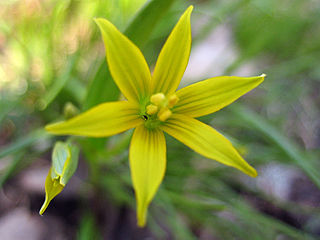
Tulipa turkestanica, the Turkestan tulip, is a species of tulip native to central Asia. It was first described by Eduard August von Regel in 1873 as a variety of T. sylvestris, then elevated to full species status two years later.

Gagea minima is a Eurasian species of plants in the lily family.

Allium ledebourianum is an Asian species of wild onion native to central and northeastern Asia: Kazakhstan, Mongolia, Russia, and China. It occurs at elevations up to 1800 m elevation.

Allium lineare is a Eurasian species of wild onions with a wide range extending from France to Mongolia.

Allium obliquum, common name lop-sided onion or twisted-leaf onion, is a Eurasian species of wild onion with a range extending from Romania to Mongolia. It is also widely cultivated elsewhere as an ornamental.
Allium platyspathum is an Asian species of wild onion. It has been reported from Xinjiang, Afghanistan, Kazakhstan, Kyrgyzstan, Mongolia, Altay Krai, Tajikistan, Uzbekistan, and Pakistan. It grows in damp locations at elevations of 1900–3700 m.
Allium polyrhizum is an Asian species of wild onion widespread across Zabaykalsky Krai, Kazakhstan, Mongolia, and China at elevations 1000–3700 m.
Allium schoenoprasoides is an Asian species of wild onion native to Xinjiang, Kazakhstan, Kyrgyzstan and Tajikistan. It can be found at elevations of 2700–3000 m.
Allium setifolium is an Asian species of wild onion native to Xinjiang, Kazakhstan, Kyrgyzstan and Mongolia. It occurs in desert regions at elevations of 400–1000 m.
Allium winklerianum is an Asian species of onion native to Xinjiang, Afghanistan, Tajikistan, Uzbekistan, Kyrgyzstan, and Tajikistan. It is also cultivated as an ornamental elsewhere because of the pretty flowers and also because of the strong lilac scent to the blooms.
Allium filidens is a species of onion found at high elevations of central and south-central Asia. It is a bulb-forming perennial up to 45 cm tall, forming a hemispherical umbel of flowers; tepals white or pink with a purple midvein.
Gagea altaica is an Asian species of plants in the lily family, native to Kazakhstan, Siberia, and Xinjiang Province of western China.
Gagea bulbifera is a Eurasian species of plants in the lily family, widespread from Romania to Xinjiang. It is native to Romania, Russia, South Caucasus, Kazakhstan, Kyrgyzstan, Iran, Turkey, Xinjiang, Western Himalayas.
Gagea divaricata is an Asian species of plants in the lily family, native to Kazakhstan, Kyrgyzstan, Tajikistan, Uzbekistan, and Xinjiang Province of western China.
Gagea fedtschenkoana is an Asian species of plants in the lily family, native to Russia, China (Xinjiang), Kazakhstan, and Mongolia.
Gagea filiformis is an Asian species of plants in the lily family, native to Russia, China (Xinjiang), Kazakhstan, Kyrgyzstan, Tajikistan, Uzbekistan, Afghanistan, Pakistan, and Mongolia.
Gagea granulosa is a Eurasian species of plants in the lily family. It is native to Russia, Kazakhstan, China (Xinjiang), and Mongolia.
Gagea jaeschkei is an Asian species of plants in the lily family. It is native to Kazakhstan, Xinjiang, Tajikistan, Uzbekistan, Afghanistan, Pakistan, and northern India.
Gagea olgae is an Asian species of plants in the lily family. It is native to Iran, Pakistan, Afghanistan, Kyrgyzstan, Tajikistan, Uzbekistan, Kazakhstan, and Xinjiang.
Gagea tenera is an Asian species of flowering plants in the lily family. It is native to Xinjiang, Central Asia, the Western Himalayas, Iran, Turkey, and South Caucasus.





